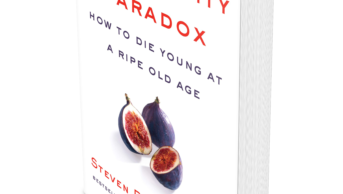
Gastro-oesophageal reflux disease will be a familiar problem to pharmacists. It is extremely common, which is clear by the wide range of over-the-counter and prescription treatments available. However, the condition can lead to oesophageal cancer which, according to Cancer Research UK, is diagnosed in 24 people each day.
Another problem for those with persistent gastro-oesophageal reflux disease is silent reflux or laryngopharyngeal reflux disease. This develops because of the constant reflux of the acidic contents of the stomach that damage the larynx and surrounding tissue leading to symptoms, such as hoarseness, a chronic and nagging cough, postnasal drip, a sore throat and the sensation of a lump in the throat.
So, is there anything that we can do to prevent gastro-oesophageal reflux disease and the accompanying silent reflux? Yes, according to this book by ear, nose and throat specialist Jonathan Aviv — we simply need to change our diet and this will have a dramatic impact on symptoms.
Aviv describes how the increased consumption of processed foods that contain a large number of acidic compounds serves only to worsen the problem. One nutritional saviour seems to be fibre, increased consumption of which is associated with a myriad of health benefits, and there is evidence to suggest that it can reduce the risk of oesophageal cancer.
One solution to lowering our consumption of acidic foods that has been widely touted around the internet is the use of alkaline diets, although this is quickly dismissed by the author as a myth.
The rest of the book describes with what are termed as the ‘healing’ and ‘maintenance’ phases of the acid watcher diet. These chapters detail the foods and activities that should be avoided, such as smoking, consumption of carbonated sodas, tea, coffee, citrus fruits and alcohol.
The two final chapters provide a number of recipes that can be tried during both the healing and maintenance phases. Another important facet, as with most diets, is the need for exercise and how this can help symptoms.
Perhaps the most important question is does the diet actually work? The only evidence presented by the author is a few specific case studies and his comment that the diet has worked for many hundreds of his patients. However, results from a recent review on the relationship between lifestyle factors and gastro-oesophageal reflux disease show that only smoking cessation and weight loss had any major impact on symptoms.
The fact that dietary changes are no panacea for gastro-oesophageal reflux disease does not stop patients experimenting to identify those foods which worsen symptoms and, therefore, to avoid them. However, most patients have probably already figured out for themselves which foods trigger their symptoms. That said, the book will be of interest to pharmacists because it provides a list of the common foods and drinks, e.g. spicy foods, alcohol, tea/coffee, which can worsen symptoms. This can then be discussed with those patients who remain unsure about the possible dietary culprits.
Finally, the book has certainly increased my awareness of silent reflux and has personally given me something to consider as a possible cause for patients who present seeking advice on these symptoms.
Rod Tucker
References
The acid watcher diet: a 28-day reflux prevention and healing programme, by Jonathan Aviv. Pp281. Price £12.99. London: Hay House UK Ltd; 2017. ISBN 978 1 78180 8566


